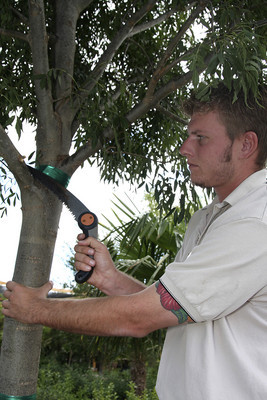FALL INTO SHAPE

It may still be 90-plus degrees Fahrenheit out there but now is the time to take a long and serious look at your lawn and garden and think about preparing it for fall and winter. Why? Well, if for no other reason, then to make our brothers and sisters in Wisconsin and North Dakota jealous. While they’re getting snow tires and snow blowers in shape, we’re getting our front and back yards in shape for November and December barbecues and other outdoor activities.
Steve Salomon, store manager at Moon Valley Nurseries in the northwest valley, said this is the time to fertilize, aerate and prune.
“Most turf grass in the valley is tall fescue, a cool-season grass,” he said. “I suggest fertilizing with 19-6-13 Moon Royale fertilizer to promote growth. To fertilize most trees and shrubs, use 16-8-4 Moon Dust. This is a well-balanced, nitrogen-based fertilizer formulated for tough desert soils. One last thing: Aerate the lawn to break up those compacted soils. This can be done with a rake or an aerator that you can rent at most garden-supply stores.”
Salomon isn’t done.
“Pruning is vital in promoting plant health,” he said. “It improves plant appearance, prevents development of weak branch structure and creates a more eye-appealing tree.”
Ron Parrish of Olympic Landscape agrees, but notes that homeowners tend to overprune.
“My first rule is never remove more than 15-30 percent of a plant,” he said. “Keep in mind the three general rules of pruning: Prune any branches that are growing in towards the center of the tree; do the same with any branches pointing toward the ground; and cut away any crossing or rubbing branches. And in spite of what you may read or hear, don’t cut back too much as it can be dangerous for the life of tree. Take some time to learn about tree growth. For instance, mesquites are fast-growing trees and will probably need to thinned about twice a year.”
Now that I have fertilized, aerated and pruned, what’s next?
“The weather is starting to cool but it’s still warm enough to plant trees and shrubs,” Salomon said. “Consider African sumacs, Tipuana tipu tree, Australian bottle trees and all ash trees. Shrubs with good fall color are cape honeysuckle, red-tip photinia (red leaves in fall and winter), and red Mexican bird of paradise.”
According to Parrish, root systems planted now will have a full year to develop and be strong enough to hold water during the hot summer months. But before that, Parrish wants everyone to clean their yards.
“People need to take time to get rid of leaves and dead plants that have collected over the past few months,” he said. “If nothing else, be aware that water collects within this debris and it creates an environment where insects thrive. If there too many bugs in your yard, all that debris could be the reason.”